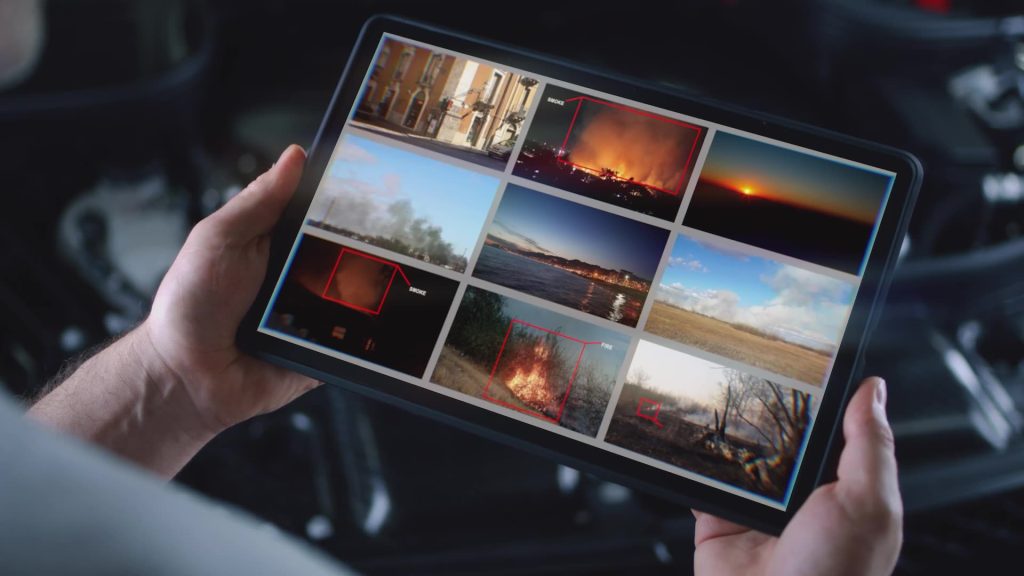Telefónica and Lenovo show how they are ready to deploy any application, on any device, anywhere.
Edge technology represents a paradigm shift in how telecommunications networks are designed, deployed, and operated, leveraging cloud computing principles and technologies to deliver more agile, efficient, and innovative telecommunication services. To usher in this change, Telefónica, one of the largest telecommunications operators in the world, came together with Lenovo, NearbyComputing, and cutting-edge AI software partners like Fogsphere and Nemergent, to show how a multi-cloud environment can bring any app to the edge at life-saving speed.
Somewhere in Madrid, a small house fire starts. Just a wisp of smoke at first, but with the potential to grow into something truly dangerous. Luckily, a public safety camera picks up the telltale signs of a fire. The AI computer vision software recognizes the threat and emergency services are able to respond faster than ever before. Once firefighters reach the scene, their mobile devices keep them up to date with the latest information, and instantly take on the functionality of a radio ‘walkie-talkie’ thanks to the Lenovo-Motorola ThinkPhone to keep the first responders connected to one another at the push of a button. In a telco network using edge technology, and operating with multi-cloud capability, all of this happens seamlessly and near instantaneously, but behind the scenes, thought leaders and industry experts are working together to make it happen in an unprecedented show of collaboration that serves as a call to action for the rest of the telco industry.
Leading at the Edge
The proof of concept began with Telefónica. Since its founding a century ago in 1924, the company has grown to become one of the largest mobile networks in the world. The mobile provider has always been at the cutting edge of telecommunications and has continued that trend with their early forays into edge computing, expanding the capabilities of their network by developing and supporting new technologies. Telefónica’s Felipe Jose Vicens Gonzalez (HW and Virtualization Infrastructure, Cloud and Infrastructure Telefónica Global IT) explains how the company sought to usher in the future of telco networks using multi-cloud applications.
“The motivation is to bring the applications closer to the users in order to improve reliability, security, and user experience,” says Felipe Vicens. “Telco edge infrastructure is introduced into the landscape, enabling new services. Telefónica’s proof of concept aims to demonstrate the benefit of leveraging a multi-cloud infrastructure to enhance edge applications, thereby opening the telecom network to new digital services that will accelerate and transform development and innovation. Furthermore, this exposes standard compute capacities for innovative products and services in any industry, including communications, entertainment, and gaming, and validates the concept of developing telco-grade applications once and deploying them anywhere.”
Public safety and emergency response seemed like the ideal way to provide the most positive impact in a way that showcased the instantaneous and seamless ways the technology can be applied, but Telefónica’s goal was also to open up avenues for collaboration and to do that, they needed to bring in experts that could show how a multi-cloud environment operates at the highest standard. The first choice was their long-time collaborator, and global tech giant, Lenovo.
Long-time Collaborators
Felipe Vicens tells how Lenovo was a natural fit for this endeavor: “The fact that Lenovo, as a provider of both devices and compute resources, can participate in different parts of the value chain of an edge deployment, together with its partnership with different applications was key to identifying the right use cases and the applications that meet the factors of multi-cloud readiness and demonstrate the telco edge multi-cloud capabilities.”
As leaders in edge technology, Telefónica knew that Lenovo had an expert grasp of the hardware requirements for such an effort, and how to best support edge applications changing requirements. Together they could employ and support the most powerful and innovative applications in a multi-cloud environment. Lenovo’s Dominique Vanhamme, (GM, WW Communication Service Providers Business Unit) was able to show how Lenovo tech would be perfect for catering to the specific needs of edge applications.
“Depending on the use case you can have applications that are bandwidth-intensive, putting a lot of pressure (and cost) on the site connectivity.” Says Vanhamme. You can also have latency-sensitive applications that require a faster response time than the one offered by the cloud or a central data center. There may also be requirements on operation resiliency where the application needs to work, even with limited network connectivity. Last and sometimes undervalued is the scalability of services as more and more data is being generated and consumed at the edge, particularly from AI and analytics. You would not want to get this large amount of data going back and forth between the edge and the data center.”
Lenovo met the challenges posed by implementing specially developed Telco Edge hardware, along with mobile tech.

“Lenovo Telco edge servers are designed with flash storage, acoustic optimization, and robust security, to be optimized for Edge and AI applications,” explains Vanhamme. “The ThinkEdge is purposely designed to operate outside of the data center, close to where the data is created and where the users need it. The short-depth form factor of the server allows it to be installed in branch offices and remote locations with no typical IT infrastructure. Lenovo Telco edge systems are reliable, low latency, and totally secure.”
Serving not only as a hardware provider, but a technology advisor and collaborator, Lenovo also brought on their long-time partner NearbyComputing to provide orchestration between the many moving parts involved in the proof of concept.
Orchestration
Nearby Computing’s CTO and Co-Founder, David Carrera, illustrates how the company’s orchestration ‘connects the computing on the back end, and the user on the front.’
“NearbyOne acts as a conductor,” explains Carrera, “harmonizing various components and facilitating smooth communication between different systems, devices, and applications. By streamlining interactions, it minimizes complexity and enhances overall efficiency. Furthermore, NearbyOne manages the deployment of AI applications like Fogsphere at the cloud and edge, overseeing their deployment, scaling, and network management.”
But Nearby Computing’s efforts went even beyond that, says Carrera.
“It is the only platform that enables a seamless orchestration between the three tiers of the network: Core, Distribution, and Access layers. This allows NearbyOne to orchestrate the deployment of 5G cores and at the same time the communication between [the application’s] MCX solution and the network. NearbyOne manages communication, data flow, and security across these tiers, ensuring efficient coordination, minimizing latency, and optimizing performance. In addition, NearbyOne integration with different ISVs ensures a marketplace and compatibility with different applications that can be deployed seamlessly at the edge or cloud, allowing reliable and fast deployments.”
The next step was to find the perfect applications to include in the process. In searching for applicable software, Telefónica paid close attention to several key criteria to make sure that the applications were ready for multi-cloud deployment.
“Due to the fact that the telco network is multi-vendor, not only in the infrastructure but also in the virtualization, it is needed to have a standard method of providing the compute capacity to run the workloads in any place, with any telco network provider.” According to Felipe Vicens, “The application must be deployed as a cloud-native network function with Kubernetes technology. For high-performance or low-latency workloads, the application must use edge hardware resources like GPUs, and the application must be close to users for privacy, internet connectivity, security, and service reliability.”
Killer Apps Save Lives
The perfect applications to fill these needs came from Fogsphere and Nemergent, two independent software vendors developing applications for computer vision and real-time communication that fit the needs of the first responders perfectly, and the companies were developing at the highest Telco-Grade standards, making them ready for multi-cloud environments.
Nemergent provided the Push-to-Talk (PTT) functionality for first responders, using their expertise to optimize their application to adjust as needs changed scale.
“Since the usage of edge deployments is devised for the partial or complete temporary offloading of traffic,” explains Eneko Atxutegui, R&D Manager at Nemergent Solutions. “The edge application or network applications over edge infrastructures ought to cope with sudden deployment and networking changes and make the whole experience seamless for the end-user. Such variable conditions force the applications to a complete decoupling of functions and availability of adjustments on the fly. Nemergent provides a cloud-native deployment of standardized 3GPP Mission Critical Services split into microservices with isolated inter-relation of functions and responsibilities. Nemergent can cope with sudden changes in the network itself as well as the service infrastructure and re-arrangements of the service to build a critical communications core.”
Fogsphere tackled the computer vision application, creating an AI safety tool for industry that provided smoke detection in this proof of concept. Fogsphere emphasized low latency, scalability, and adaptive learning, proving the utility of computer vision and other AI applications at the edge.
Fogsphere is at the forefront of revolutionizing industrial safety through computer vision, as outlined by CEO and Co-founder Pasquale Giampa.
“Fogsphere leverages edge computing to process data directly on devices at the site, significantly reducing latency. This enables instant detection and action on safety incidents, crucial in environments where time is of the essence for preventing and reacting to accidents. The platform employs machine learning techniques that evolve over time, steadily improving in accuracy and efficiency. This adaptive learning ensures that Fogsphere becomes more effective at spotting potential hazards the more it interacts with the specific environment of deployment.”
Both Nemergent and Fogsphere also emphasized interoperability, to ensure functionality in the multi-cloud. At implementation, the applications would need to deploy using Kubernetes technology and be able to run seamlessly across multiple platforms, including Redhat, Windriver, and Robin.io. Telefónica and its collaborators took an API-centric approach to enable interaction and customization by other systems as necessary.
A Call to Action
Telefónica believes the success of this proof of concept represents the future of telco networks, and they are already continuing to pursue the promise of multi-cloud environments.
“Telefónica is bringing the opportunity to any developer to deploy telco-grade applications in telecom networks.” Says Felipe Vicens, “With this proof of concept, we are demonstrating that the telco-edge infrastructure is ready to support any telco-grade application. Opening the telco edge infrastructure to any developer that wants to create a telco-grade application that may be deployed anywhere, is an important milestone in new architectures with endless possibilities. This proof of concept has demonstrated that the developers can focus their efforts on the application itself and not on the infrastructure where the service will be run.”
This proof of concept has demonstrated that when smoke starts billowing, Fogsphere’s AI can recognize and respond using the mobile network, leveraging Lenovo edge servers, and activating emergency responders. When those emergency responders arrive, edge devices instantly download and run new applications through orchestration from Nearby Computing, and Lenovo-Motorola mobile devices become PTT tools for firefighters to stay connected, all of this growing in scale and capability depending on changing needs, and working in a multi-cloud environment that functions seamlessly regardless of the developer or the platform. A truly impressive collaboration, but Telefónica and Lenovo aim to use this to set the new standard for how telco networks can function.
The global telecommunications network is changing, and Telefónica is ready to begin deploying applications that use edge tech and AI in a multi-cloud environment. Industry leaders and experts came together to bring this concept to life. Telefónica, along with Lenovo and collaborators at NearbyOne, Fogsphere, and Nemergent, demonstrates how best-in-class telco-grade applications can revolutionize the future of telco networks, and that the future is already here. This proof of concept represents an open call to developers and industries everywhere: The network is ready.
Learn more about Lenovo’s edge computing capability at Lenovo.com/the edge



